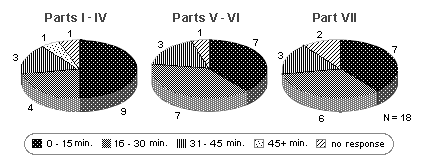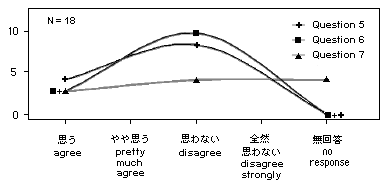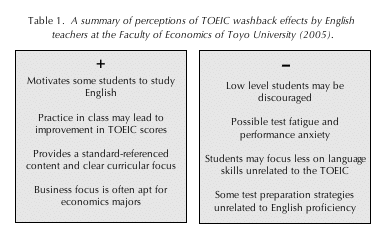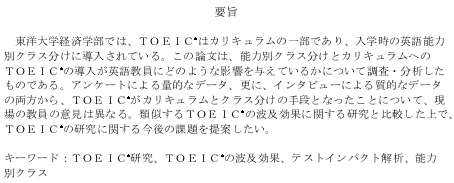Toyo University Keizai Ronshu. Vol 31. No. 1. Dec. 2005. (p. 83 - 106)

 PDF Version
PDF Version
TOEIC® washback effects on teachers:
by Tim Newfields
|
|
This paper explores how the use of the TOEIC® as a streaming tool and curricular component at one faculty in a Japanese university has impacted EFL teachers there.
Both quantitative and qualitative data reveal mixed reactions to the use of this test as a placement tool and part of the curriculum. After comparing the results of this study with related test washback
research, suggestions for additional TOEIC research are offered.
|
Previous Research
| "Since a lot of money and prestige is at stake in hi-stakes tests such as the TOEIC, objective measures such as recorded behaviors or test scores should supplement self-reports." |
[The TOEIC] is still based on the structuralist, behaviorist model of language learning and testing that informed discrete-point testing. If ETS has accepted this model is no longer suitable as a basis for the TOEFL, why has TOEIC not been treated similarly? (p. 3)
It would appear that students are much closer in ability when it comes to language competence than the TOEIC test scores would demonstrate. It also suggests that the TOEIC was not an accurate method for determining group levels for these learners. (p. 46)
Research Questions
(1) Placement/Streaming
(2) Classroom Time Allocations
(3) Content Appropriacy
(4) Student Interest
(5) Consequential Validity
(6) Pedagogical Changes
(7) Future Changes
Methods
ParticipantsInstruments
Procedure
The interviews in Phase Two were conducted in April-July 2005 and responses were recorded on an interview sheet promptly following each interview.
Results and Discussion
| "78% of the respondents (N=14) . . . [indicated] general support for the TOEIC as a streaming tool." |
Question 1
The first question concerned whether the respondents felt the TOEIC was useful as a classroom streaming tool. 78% of the respondents (N=14) responded positively to this question. 14% of the respondents (N=3) responded negatively and seven respondents offered no response. This data suggest there is general support for the TOEIC as a streaming tool.
| "Anyone who understands basic statistics should question whether the TOEIC is an appropriate tool for screening incoming Japanese university freshmen." |
Questions 2-4

Figure 1. The amount of time per 90 minute class the university teacher sindicated devoting to TOEIC study.
If the data in Figure 1 represents an accurate picture of what is actually happening in class, it would appear that only a minority of teachers devote most of class time to explicit TOEIC instruction. The majority focus on other materials, spending most of the lesson on activities other than explicit test preparation.
| "students with relatively high TOEIC scores tend to be pro-active in attempting to raise their scores further, yet those with low scores tend to perceive themselves as 'bad English learners' and easily get stuck in a rut of ennui." |
Question 5
Question 6
The TOEIC programme generally recommends that learners whose native language is that of Western European origin do not take the TOEIC test until they have received at least 60 hours of English training and/or practice. Native speakers of languages from other origins should probably wait at least 100 hours. (p. 12)
| "market-driven drives to produce 'quick results' may downgrade the effectiveness of some programs and place substantial burdens on both students and teachers." |
Question 7

Figure 2. A comparison of responses to survey questions 5 - 7.
Question 8
The TOEIC was not designed to be a summative test measuring learned content. As Childs pointed out a decade ago, it is not an appropriate way to gauge what individuals learn over a period of time. To evaluate what students may have learned, a more appropriate method would be to adopt a criterion-referenced test.
| "Issues of practicality and face validity are likely to weigh more heavily in the minds of non-experts than concerns about construct validity when making test planning decisions." |
Question 9
Question 10
Conclusion and Implications

Since the TOEICis likely to remain a facet of English education for some time to come, further research is in order. Specifically, these questions merit additional exploration:
1. Teacher Impact Elsewhere
What impact is the TOEIC having on teachers at other institutions? It would be especially interesting to expand this pilot study and compare schools with hi-stakes, hi-intensity TOEIC programs (such as Yamaguchi and Hiroshima universities) with those which have relatively low-stakes, low-intensity programs (such as Toyo and Tokai Universities). In hi-stakes settings students are required to obtain a specific TOEIC score to graduate and/or teacher evaluation is measured at least in part on the basis of score gains.
2. Student Impact
What impact is the TOEIC having on students at other institutions? More information about student backwash effects would be worth investigating. A hypothesis to explore is that the TOEIC provides a positive incentive for students with higher scores, but may lead weaker students to develop negative attitudes.
3. Meta-Learning Strategies
How do students who perform well on the TOEIC differ from those who don't? What meta-learning strategies do more competent students use that differs from less successful ones?4. Correlation and Validation Studies
How do TOEIC scores correlate with other English proficiency test scores? It may be useful to replicate some previous correlation studies in a Toyo University context to make sure that tests results reported for different populations also apply here. Since many TOEIC research studies were conducted with small populations and/or have design errors it would also be worth validating some previous.
Since the TOEIC holds a dominant position in English language testing in Asia, these questions are worth exploring. Over four million people have taken that exam since its inception, 72% of them Japanese (ETS, 2004). When we examine the volume of research that has been conducted on the TOEIC and compare it with other large-scale tests such as the TOEFLor IELTS, it becomes evident that much work remains to be done — particularly in light of the 2005 revised TOEIC. Since this version of the test appears to be more difficult than the previous version, its backwash patterns are likely to differ.
| "Used in conjunction with other measures, the TOEIC may give us valuable insights into the language proficiency of an examinee. However, as a sole yardstick of language proficiency, it is subject to marked distortions." |
|
Acknowledgements Many thanks to Kondoh Hiroko and Katou Osamu for help in constructing the Phase One Survey. |
References
Alderson, J.C., & Wall, D. (1993). Does washback exist? Applied Linguistics, 14 (2), 115-129.
Bachman, L. F., & Palmer, A. S. (1996). Language testing in practice. Oxford University Press.
Brown, J. D. (1988). Understanding research in second language learning: A teacher's guide to statistics and research design. Cambridge University Press.
Brown, J. D. (2000, January). University entrance examinations: Strategies for creating positive washback on English language teaching in Japan. Shiken: JALT Testing & Evaluation SIG Newsletter, (3) 2, 4-8. Retrieved February 27,2005 from jalt.org/test/bro_5.htm.
Bruner, J. S. (1960). The process of education. Cambridge: Harvard University Press.
Chapman, M. (2003). TOEIC: Tried but undertested. SHIKEN: JALT Testing & Evaluation SIG Newsletter, (7) 2, 2-5. Retrieved February 21, 2005 from jalt.org/test/cha_1.htm.
Cheng, L., Watanabe, Y., & Curtis, A. (2003). Washback in language testing: Research contexts and methods. Mahwah, NJ / London: Lawrence Erlbaum Assoc.
Childs, M. (1995). Good and bad uses of TOEIC by Japanese companies. In J.D. Brown & S. O. Yamashita (Eds.). Language Testing in Japan. (pp. 66-75). Tokyo, Japan: JALT.
Cunningham, C. R. (2002). The TOEIC test and communicative competence: Do test score gains correlate with increased competence? Unpublished M. A. Dissertation. University of Birmingham. Retrieved March 15, 2005 from www.cels.bham.ac.uk/resources/essays/Cunndiss.pdf.
Educational Testing Service. (2005). TOEIC Technical Manual. Retrieved August 27, 2005 from www.toeic.cl/down/toeic_tech_man.pdf.
Flyman-Mattsson, A., & Burenhult, N. (1999). Code-switching in second language teaching of French. Lund University, Dept. of Linguistics Working Papers, 47, 59-72. Retrieved August 24, 2005 from www.ling.lu.se/disseminations/ pdf/47/Flyman_Burenhult.pdf.
Griffee, D. (1998, October). Can we validly translate questionnaire items from English to Japanese? Shiken: JALT Testing & Evaluation SIG Newsletter, 2 (2), 15-17. Retrieved April 15, 2005 from jalt.org/test/gri_1.htm.
Hajipournezhad, G. (2004). An approach to the validation of judgments in language testing in T. Newfields, S. Yamashita, A. Howard, & C. Rinnert (eds.) 2003 JALT Pan-SIG Conference Proceedings. Tokyo: JALT Pan-SIG Committee. (p. 80 - 84). Retrieved June 5, 2005, from jalt.org/pansig/2003/HTML/HajiPourNezhad.htm.
Haladyna, T., Nolan, S., & Hass, N. (1991, June/July). Raising standardized achievement test scores and the origins of test score pollution. Educational Researcher, 20 (5), 2-7.
Hilke, R., & Wadden, P. (1997). The TOEFL and its imitators: analyzing the TOEFL and evaluating TOEFL-prep texts. RELC Journal, 28 (1), 28-53.
Hirai, M. (2002, September). Correlations between active skill and passive skill test scores. Shiken: JALT Testing & Evaluation SIG Newsletter, 6 (3), 2 - 8. Retrieved July 6, 2005, from jalt.org/test/hir_1.htm.
Hirai, M. (2005, September 2). Clothes make the man: A viewpoint of a lifelong English learner. Presentation at the 9th Annual JLTA Conference. Faculty of Information Studies, Shizuoka Sangyo University (Fujieda Campus).
Hughes, A. (1989). Testing for language teachers. Cambridge University Press.
Ikeda, M. (2005, March). Untitled Presentation. TOEIC Training Seminar sponsored by the TOEIC Kenkyuu-kai. Osaka, Japan.
Institute for International Business Communications. (2004, January). TOEIC Newsletter #84 (Digest Version). Retrieved March 1, 2005 from www.toeic.or.jp/toeic /data/pdf/NewsL87.pdf.
Institute for International Business Communications. (2005, July). TOEIC Deeta / Kakushuu Shiryou: Kore Made no TOEIC Koukai Heikin Sukoa. [TOEIC Data / Misch. Resources: Prior Public g Scores]. Retrieved August 24, 2005 from https://www.toeic.or.jp/toeic/data/data01.html.
Iwabe, K. (2005, March). Untitled Presentation. TOEIC Training Seminar sponsored by IIBC. Osaka, Japan.
Kohn, A. (1999, September 15). Confusing harder with better. Education Week. Retrieved June 20, 2005 from www.alfiekohn.org/teaching/edweek/chwb.htm.
Nall, T. (2004). TOEIC: A discussion and Analysis. ELT Two Cents Cafe. Retrieved May 22, 2005 from www.geocities.com/twocentseltcafe/teach/TOEIC.html.
Robb, T., & Ercanbrack, J. (1999). A study of the effect of direct test preparation on the TOEIC scores of Japanese University students. TESL-EJ , 3 (4) A-2. (p. 1-22). Retrieved March 12, 2005 from www-writing.berkeley.edu/TESL-EJ/ej12/a2.html.
Saegusa, Y. (1985). Prediction of English proficiency progress. Musashino English and American Literature, (18) Tokyo: Musashino Women's University. Cited in Pro Lingua (2000). TOEIC Info. Retrieved August 22, 2005 from www.prolingua.co.jp/TOEIC.html.
Shohamy, E. (1993). A collaborative/diagnostic feedback model for testing foreign languages. In D. Douglas & C. Chapelle (Eds.), A new decade of language testing research. (pp. 185-202). Alexandria, VA: TESOL Publications.
Templer, B. (2004, March). High-stakes testing at high fees: Notes and queries on the international English proficiency assessment market. Journal for Critical Education Policy Studies, 2 (1). Retrieved August 22, 2005, from www.jceps.com/index.php?pageID=article&articleID=21.
TOEICEuropean Service. (2002, December). How quickly will candidates see improvements in TOEIC scores? TOEIC From A to Z. (Section 2.11). Retrieved August 22, 2005, www.eabhes.org/php/IMG/pdf/doc-166.pdf
